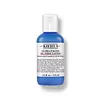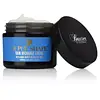What's inside
What's inside
 Key Ingredients
Key Ingredients

 Benefits
Benefits

 Concerns
Concerns

 Ingredients Side-by-side
Ingredients Side-by-side

Glycoproteins
Skin ConditioningPlant Ash Extract
Tocopherol
AntioxidantWater
Skin ConditioningGlycerin
HumectantAlcohol Denat.
AntimicrobialIsononyl Isononanoate
EmollientAmmonium Polyacryloyldimethyl Taurate
Emulsion StabilisingPhenoxyethanol
PreservativeImperata Cylindrica Root Extract
Skin ConditioningDivinyldimethicone/Dimethicone Copolymer
Tocopheryl Acetate
AntioxidantPolyperfluoromethylisopropyl Ether
Skin ConditioningHexylene Glycol
EmulsifyingCaprylyl Glycol
EmollientBeheneth-10
EmulsifyingPanthenol
Skin ConditioningPEG-100 Stearate
Glyceryl Stearate
EmollientPolyacrylamide
Xanthan Gum
EmulsifyingPseudoalteromonas Ferment Extract
HumectantFructose
HumectantBHT
AntioxidantGlucose
HumectantC13-14 Isoparaffin
EmollientBiosaccharide Gum-1
HumectantMenthol
MaskingDisodium EDTA
C12-13 Pareth-23
CleansingLaureth-7
EmulsifyingC12-13 Pareth-3
EmulsifyingTriethanolamine
BufferingCarbomer
Emulsion StabilisingUrea
BufferingDextrin
AbsorbentAcrylates/C10-30 Alkyl Acrylate Crosspolymer
Emulsion StabilisingHexyl Nicotinate
EmollientSucrose
HumectantGlutamic Acid
HumectantAspartic Acid
MaskingAlanine
MaskingGlycoproteins, Plant Ash Extract, Tocopherol, Water, Glycerin, Alcohol Denat., Isononyl Isononanoate, Ammonium Polyacryloyldimethyl Taurate, Phenoxyethanol, Imperata Cylindrica Root Extract, Divinyldimethicone/Dimethicone Copolymer, Tocopheryl Acetate, Polyperfluoromethylisopropyl Ether, Hexylene Glycol, Caprylyl Glycol, Beheneth-10, Panthenol, PEG-100 Stearate, Glyceryl Stearate, Polyacrylamide, Xanthan Gum, Pseudoalteromonas Ferment Extract, Fructose, BHT, Glucose, C13-14 Isoparaffin, Biosaccharide Gum-1, Menthol, Disodium EDTA, C12-13 Pareth-23, Laureth-7, C12-13 Pareth-3, Triethanolamine, Carbomer, Urea, Dextrin, Acrylates/C10-30 Alkyl Acrylate Crosspolymer, Hexyl Nicotinate, Sucrose, Glutamic Acid, Aspartic Acid, Alanine
Water
Skin ConditioningGlycerin
HumectantDimethicone
EmollientIsononyl Isononanoate
EmollientAlcohol Denat.
AntimicrobialPrunus Armeniaca Kernel Oil
MaskingPolysorbate 20
EmulsifyingPropanediol
SolventPEG-20 Methyl Glucose Sesquistearate
EmulsifyingAmmonium Polyacryloyldimethyl Taurate
Emulsion StabilisingPolyacrylamide
Phenoxyethanol
PreservativeCaprylyl Glycol
EmollientHydroxypropyl Tetrahydropyrantriol
Skin ConditioningC13-14 Isoparaffin
EmollientPropylene Glycol
HumectantCaffeine
Skin ConditioningVigna Aconitifolia Seed Extract
Skin ConditioningDisodium EDTA
Laureth-7
EmulsifyingBHT
AntioxidantMagnesium Gluconate
Skin ConditioningXanthan Gum
EmulsifyingSodium Cocoyl Glutamate
CleansingPentylene Glycol
Skin ConditioningHydrolyzed Soy Protein
HumectantT-Butyl Alcohol
PerfumingTocopherol
AntioxidantWater, Glycerin, Dimethicone, Isononyl Isononanoate, Alcohol Denat., Prunus Armeniaca Kernel Oil, Polysorbate 20, Propanediol, PEG-20 Methyl Glucose Sesquistearate, Ammonium Polyacryloyldimethyl Taurate, Polyacrylamide, Phenoxyethanol, Caprylyl Glycol, Hydroxypropyl Tetrahydropyrantriol, C13-14 Isoparaffin, Propylene Glycol, Caffeine, Vigna Aconitifolia Seed Extract, Disodium EDTA, Laureth-7, BHT, Magnesium Gluconate, Xanthan Gum, Sodium Cocoyl Glutamate, Pentylene Glycol, Hydrolyzed Soy Protein, T-Butyl Alcohol, Tocopherol
Ingredients Explained
These ingredients are found in both products.
Ingredients higher up in an ingredient list are typically present in a larger amount.
Alcohol Denat. is an alcohol with a denaturant property. It is created by mixing ethanol with other additives.
This ingredient gets a bad rep because it is irritating and drying - mostly due to its astringent property. Astringents draw out natural oils in tissue, constricting pores and leaving your skin dried out.
However, alcohol denat. is not all that bad.
Due to its low molecular weight, alcohol denat. tends to evaporate quickly. One study on pig skin found half of applied alcohol evaporated in 10 seconds and less than 3% stayed on skin.
This also helps other ingredients become better absorbed upon application.
Studies are conflicted about whether this ingredient causes skin dehydration. One study from 2005 found adding emollients to propanol-based sanitizer decreased skin dryness and irritation. Another study found irritation only occurs if your skin is already damaged.
Small amounts of alcohol are generally tolerated by oily skin or people who live in humid environments.
The rule of thumb is if this alcohol is near the end of an ingredients list, it will probably not affect your skin much.
Also...
This ingredient has antimicrobial and solvent properties.
The antimicrobial property helps preserve products and increase their shelf life. As a solvent, it helps dissolve other ingredients.
Other types of astringent alcohols include:
Learn more about Alcohol Denat.Ammonium Polyacryloyldimethyl Taurate is a polymer made from ammonium salts. It helps add stability and texture to a product. This ingredient is stable over a wide pH range.
Due to its ability to absorb water, it can help thicken the texture of a product. As an emulsion stabilizer, this ingredient is stabilizes other ingredients to create a consistent texture.
According to a manufacturer, it helps create a "smooth, light and fresh" texture.
Learn more about Ammonium Polyacryloyldimethyl TaurateBHT is a synthetic antioxidant and preservative.
As an antioxidant, it helps your body fight off free-radicals. Free-radicals are molecules that may damage your skin cells.
As a preservative, it is used to stabilize products and prevent them from degrading. Specifically, BHT prevents degradation from oxidation.
The concerns related to BHT come from oral studies; this ingredient is currently allowed for use by both the FDA and EU.
However, it was recently restricted for use in the UK as of April 2024.
Learn more about BHTThis ingredient is also known as "C13-14 Isoalkane".
C13-14 Isoparaffin is created from petroleum-based mineral oils. It is an emollient and helps thicken a product.
As an emollient, it helps keep the skin soft and smooth by creating a barrier on top. This barrier traps moisture in, keeping the skin hydrated.
C13-14 Isoparaffin may not be fungal-acne safe.
Learn more about C13-14 IsoparaffinCaprylyl Glycol is a humectant and emollient, meaning it attracts and preserves moisture.
It is a common ingredient in many products, especially those designed to hydrate skin. The primary benefits are retaining moisture, skin softening, and promoting a healthy skin barrier.
Though Caprylyl Glycol is an alcohol derived from fatty acids, it is not the kind that can dry out skin.
This ingredient is also used as a preservative to extend the life of products. It has slight antimicrobial properties.
Learn more about Caprylyl GlycolDisodium EDTA plays a role in making products more stable by aiding other preservatives.
It is a chelating agent, meaning it neutralizes metal ions that may be found in a product.
Disodium EDTA is a salt of edetic acid and is found to be safe in cosmetic ingredients.
Learn more about Disodium EDTAGlycerin is already naturally found in your skin. It helps moisturize and protect your skin.
A study from 2016 found glycerin to be more effective as a humectant than AHAs and hyaluronic acid.
As a humectant, it helps the skin stay hydrated by pulling moisture to your skin. The low molecular weight of glycerin allows it to pull moisture into the deeper layers of your skin.
Hydrated skin improves your skin barrier; Your skin barrier helps protect against irritants and bacteria.
Glycerin has also been found to have antimicrobial and antiviral properties. Due to these properties, glycerin is often used in wound and burn treatments.
In cosmetics, glycerin is usually derived from plants such as soybean or palm. However, it can also be sourced from animals, such as tallow or animal fat.
This ingredient is organic, colorless, odorless, and non-toxic.
Glycerin is the name for this ingredient in American English. British English uses Glycerol/Glycerine.
Learn more about GlycerinIsononyl Isononanoate is a synthetic skin-conditioner and texture enhancer. It is created from nonanoic acid, a fatty acid found in cocoa and lavender oil.
As an emollient, Isononyl Isononanoate helps keep your skin soft and smooth. This is because emollients create a barrier on the skin to trap moisture in.
Isononyl Isononanoate helps give products a velvet feel and improves spreadability.
Learn more about Isononyl IsononanoateLaureth-7 is created by the ethoxylation of lauryl alcohol using ethylene oxide. Lauryl alcohol is a fatty alcohol with hydrating properties.
This ingredient is an emulsifier and cleansing ingredient. As an emulsifier, it is used to prevent ingredients from separating. It also helps cleanse the skin by gathering dirt, oil, and pollutants to be rinsed away.
Phenoxyethanol is a preservative that has germicide, antimicrobial, and aromatic properties. Studies show that phenoxyethanol can prevent microbial growth. By itself, it has a scent that is similar to that of a rose.
It's often used in formulations along with Caprylyl Glycol to preserve the shelf life of products.
Polyacrylamide is a synthetic polymer. It is used to stabilize products and bind ingredients. When hydrated, Polyacrylamide forms a soft gel.
Polyacrylamide is low-toxicity. If source properly, it is deemed safe to use in cosmetics.
It should be noted the precursor to Polyacrylamide is acrylamide. Acrylamide is a carcinogen. Most reputable sources of Polyacrylamide will screen for residual acrylamide to make sure the count is in a safe range. Acrylamide is not able to be absorbed through the skin.
We recommend speaking with a professional if you have concerns.
Learn more about PolyacrylamideTocopherol (also known as Vitamin E) is a common antioxidant used to help protect the skin from free-radicals and strengthen the skin barrier. It's also fat soluble - this means our skin is great at absorbing it.
Vitamin E also helps keep your natural skin lipids healthy. Your lipid skin barrier naturally consists of lipids, ceramides, and fatty acids. Vitamin E offers extra protection for your skin’s lipid barrier, keeping your skin healthy and nourished.
Another benefit is a bit of UV protection. Vitamin E helps reduce the damage caused by UVB rays. (It should not replace your sunscreen). Combining it with Vitamin C can decrease sunburned cells and hyperpigmentation after UV exposure.
You might have noticed Vitamin E + C often paired together. This is because it is great at stabilizing Vitamin C. Using the two together helps increase the effectiveness of both ingredients.
There are often claims that Vitamin E can reduce/prevent scarring, but these claims haven't been confirmed by scientific research.
Learn more about TocopherolWater. It's the most common cosmetic ingredient of all. You'll usually see it at the top of ingredient lists, meaning that it makes up the largest part of the product.
So why is it so popular? Water most often acts as a solvent - this means that it helps dissolve other ingredients into the formulation.
You'll also recognize water as that liquid we all need to stay alive. If you see this, drink a glass of water. Stay hydrated!
Learn more about WaterXanthan gum is used as a stabilizer and thickener within cosmetic products. It helps give products a sticky, thick feeling - preventing them from being too runny.
On the technical side of things, xanthan gum is a polysaccharide - a combination consisting of multiple sugar molecules bonded together.
Xanthan gum is a pretty common and great ingredient. It is a natural, non-toxic, non-irritating ingredient that is also commonly used in food products.
Learn more about Xanthan Gum